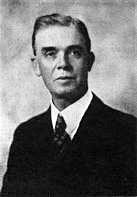
William Frederic Badè served on the Sierra Club board of directors for nearly three decades. He was the third president of the Sierra Club, serving for three years.
Most importantly, perhaps, he was the editor of the Sierra Club Bulletin for 12 years. It was his editorial skill that transformed the Bulletin from a periodical of primarily local interest to a leading national publication on wilderness preservation and conservation.
After John Muir's death in 1914, Muir's daughters Wanda and Helen chose Badè to edit their father's unpublished papers. He was responsible for editing Muir's books A Thousand Mile Walk to the Gulf, The Cruise of the Corwin, Steep Trails, and The Life and Letters of John Muir.
For the latter work, Badè had hoped to locate a thousand letters; he ultimately accumulated nearly double that number. In a garret in Indiana, he discovered Muir's collection of botanical specimens, the remnants of a trip through Canada. From the dates and notations on these specimens, Dr. Badè was able to trace Muir's movements during a little-known period of his life.
Badè's papers, especially those relating to John Muir, may today be found in the University of the Pacific, Holt-Atherton Library Special Collections.
Badè's professional life was also interesting. He was a professor at the Pacific School of Religion in Berkeley. A theologian and an archaeologist, he graduated at Moravian College, Pennsylvania, in 1892, the same year the Sierra Club was established. Later he received a B.D. degree from both the Moravian Theological Seminary and Yale, and a Ph.D degree in 1898.
He studied geology and mineralogy for several years, and pursued undergraduate courses at the university of Berlin in 1905-1906 and in Paris in 1909. Beginning his career as a professor of Greek and German at Moravian College, and for years as professor of Hebrew and Old Testament Literature in the Moravian theological seminary, in 1902 he accepted the position of chair of Old Testament Literature and Semitic languages at the Pacific School of Religion.
He served in this position for the rest of his life, but also served as dean and acting president in later years. In 1928 he pursued archeological research in Palestine. Excavations conducted under his supervision resulted in the discovery of the ruins of several cities, as well as many antiquities. He was the author of several theological books and reports about his archeological expeditions.
In 1913, he was instrumental in founding the California Botanical Society, and he was president of the California Associated Societies for the Conservation of Wild Life.
In 1906, he married Evelyn Marianne Ratcliff, whom he had met on a Sierra Club outing and who, like him, was fond of mountain climbing and outdoor life. She died the next year, leaving a daughter. In 1917, he married Elizabeth Le Breton Marston, another member of the Sierra Club whom he had met on its outings, and this union resulted in two more children.
For more about Dr. Badè and his Sierra Club activities and adventures, see the Tribute to William Frederic Badè by William E. Colby, which also contains a comprehensive biographical timeline.